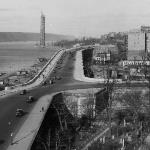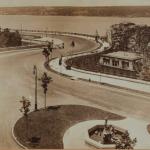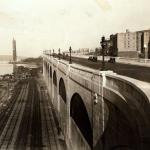Extended by a viaduct over the valley at 125th Street to a junction with the Boulevard Lafayette, the Drive would open up one of the most picturesque and interesting parts of the city, now quite unknown to its people.
New York Times
January 29, 1897
Borough President Cantor came in for considerable adverse criticism in connection with the Riverside Drive extension yesterday in Special Term, Part I., of the Supreme Court, when the attorney for the Lansing Investment Company, owners of Audubon Park, sought to obtain from Justice McCall a writ of peremptory mandamus to compel the Borough President to proceed with the improvement. New York Times
March 10, 1903
It is doubtful if such a project ever would have been started had it not been for the indomitable perseverance of a few large landholders along the upper part of the planned course of the drive, who persisted in the face of almost overwhelming opposition for many years before they gained their objective. New York Times
New York Times
July 10, 1904
That section of Riverside Drive Extension between 145th and 158th Streets has been completed and was opened to the public last week.
New York Times
February 2, 1912
Riverside Drive
What eventually doomed the Audubon home was Riverside Drive. You will notice that the drive splits here at the traffic light and proceeds in two directions (the 155th Street sign is deceptive). This split is another clue to Audubon Park’s past: the parallel metal bands in the street mark the original drive's inward curve.
The first portion of Riverside Drive, which opened in 1880, terminated around 125th Street, just before the Manhattan valley. Contention and debate had nearly derailed construction of Riverside Avenue (as it was originally called) and the predicted real estate boom it was to have brought did not immediately materialize. Even so, the city began making plans to extend the drive northward to meet Boulevard Lafayette, which began at 156th Street and Broadway, where you began your walk.
However, some property owners along the proposed route of the Riverside Drive Extension protested, especially here at 155th Street, where the directors of the Trinity Corporation balked at the idea of ceding the one hundred feet of land necessary for the drive’s construction. Their reluctance antagonized other landowners, especially the Grinnell family which was fully aware of the economic advantages of a Riverside Drive address. The Grinnells would derive the greatest benefit if the extended Riverside Drive crossed Audubon Park on a diagonal from 155th Street to 158th Street, as that path would give them maximum frontage on what many believed would become the most desirable avenue in Manhattan.
The dispute between these opposing forces came to a head in1897, when a group of landowners, including real estate attorney Newell Martin (Laura Grinnell's husband) descended on Albany. A compromise bill passed that day. The Trinity Corporation agreed to give up fifty-five feet of the hundred needed; the remaining forty-five feet would be cantilevered over the railroad tracks. For their (apparently undisclosed) role in negotiating the compromise, the Grinnells received a plum: Riverside Drive would turn at 155th Street and cross Audubon Park on a snaking diagonal to meet Boulevard Lafayette at 158th Street, outlining a large part of their property line. A forty-foot retaining wall supporting the new drive would separate the three Audubon houses – property that the Grinnells had nevert owned – from the rest of Audubon Park.
Over the next decade, politicians would try to halt, hinder, and change the drive’s path. Despite that, this portion of Riverside Drive officially opened in February 1911, the same time several of the large apartment houses opened to their first residents.
Immediately, drivers began complaining about the three sharp curves between 155th and 158th Streets. So, the city went back to the drawing board. The solution – a viaduct along the river to bridge the gap between 155th and 161st Streets – had been one of the original options. The new viaduct, which left the Audubon house in a dark well with access via a service road that bore the euphemistic name of Audubon Lane, led directly to the house's demise.
 | ||||
 | ||||
Two Riverside Drives
1932
(click to enlarge)
 | ||||
"New" Riverside Drive at 155th Street
click to enlarge)
Minnie's Land Map: 1851
(click to enlarge)
Continue your walk . . .
Funded by the Audubon Park Alliance


